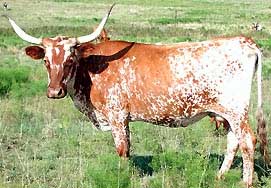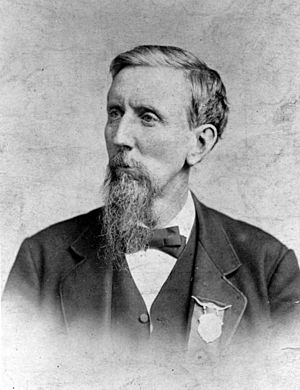Joseph McCoy facts for kids
Joseph "Cowboy" McCoy (born December 21, 1837 – died October 19, 1915) was a smart businessman from the 1800s. He became famous for helping move thousands of Longhorn cattle from Texas to markets in the eastern United States. He created a new way to get cattle to buyers, which changed the cattle industry.
Joseph McCoy's Early Life
Joseph Getting McCoy was one of eleven children. His parents were Mary and David McCoy. He was born on December 21, 1837, in Sangamon County, Illinois. His family worked as farmers.
Joseph went to school, even spending a year at Knox College. Later, he started a business as a stockman. This meant he bought, raised, and sold animals like mules.
A big chance came for McCoy in 1861. He sold a whole train car full of mules in Kentucky. This trip taught him a lot about moving goods by train. This knowledge helped him greatly in his main business idea six years later. The money he earned also allowed him to marry Sarah Epler, who was a neighbor.
Moving Cattle to Market

In the 1860s, cattle ranchers in Texas had trouble selling their longhorn cattle. They needed to get them to markets far away. People who had settled in Kansas (called homesteaders) did not want the cattle crossing their land. They worried the cattle might carry ticks. These ticks could spread a sickness called Texas Fever. This disease was deadly to other types of cattle. Longhorns could get sick, but they were stronger and usually did not die from it.
McCoy knew that railroad companies wanted to move more goods. He saw this as a great business chance. McCoy decided to build a hotel, a large pen for cattle (called a stockyard), an office, and a bank. He built these in a small town along the Kansas Pacific Railway. This railroad is now known as the Union Pacific.
This small town became famous as Abilene, Kansas. It was one of the first "cow towns." McCoy's plan was simple: cattle would be herded from Texas to Abilene. From there, they would be loaded onto trains. The trains would then take them to bigger cities in the Midwest and the East.
Abilene was located near the end of the Chisholm Trail. This trail was named after Jesse Chisholm. It was first used during the American Civil War to supply the Confederate army. The trail ran west of where people had settled in Kansas. This meant cattle could be driven without bothering the Kansas homesteaders.
McCoy advertised his new cattle market all over Texas. He wanted cattle owners to bring their herds to Abilene. By 1870, thousands of Texas longhorn cattle were being driven along the Chisholm Trail. They were all headed to Abilene. By 1871, as many as 5,000 cowboys were paid on a single day. Abilene became known as a wild town in the Old West.
Longhorn cattle were perfect for these long journeys. They had long legs and tough hooves. They even gained weight while traveling to market. People say McCoy once bragged he would bring 200,000 cattle in 10 years. He actually brought two million cattle in just four years! This success led to the saying, "It's the Real McCoy," meaning something is genuine or true.
Later Life and Legacy
Joseph McCoy also wrote a book. It was called Historic Sketches of the Cattle Trade of the West and Southwest. This book was published in 1874.
Joseph McCoy died in Kansas City, Missouri on October 19, 1915.
In 1967, he was honored for his work. He was added to the Hall of Great Westerners. This hall is part of the National Cowboy & Western Heritage Museum.



